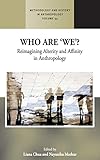Who are 'We'? : Reimagining Alterity and Affinity in Anthropology / ed. by Nayanika Mathur, Liana Chua.
Material type: TextSeries: Methodology & History in Anthropology ; 34Publisher: New York ; Oxford : Berghahn Books, [2018]Copyright date: ©2018Description: 1 online resource (264 p.)Content type:
TextSeries: Methodology & History in Anthropology ; 34Publisher: New York ; Oxford : Berghahn Books, [2018]Copyright date: ©2018Description: 1 online resource (264 p.)Content type: - 9781785338885
- 9781785338892
- 305.8 23
- GN495.6 .W46 2018
- online - DeGruyter
| Item type | Current library | Call number | URL | Status | Notes | Barcode | |
|---|---|---|---|---|---|---|---|
 eBook
eBook
|
Biblioteca "Angelicum" Pont. Univ. S.Tommaso d'Aquino Nuvola online | online - DeGruyter (Browse shelf(Opens below)) | Online access | Not for loan (Accesso limitato) | Accesso per gli utenti autorizzati / Access for authorized users | (dgr)9781785338892 |
Frontmatter -- Contents -- List of Figures -- Acknowledgements -- Introduction. Who Are ‘We’? -- Part I. Revisiting the Anthropological ‘We’ -- Chapter 1. Anthropology at the Dawn of Apartheid: Radcliffe-Brown and Malinowski’s South African Engagements, 1919–34 -- Chapter 2. The Savage Noble: Alterity and Aristocracy in Anthropology -- Part II. Alterity and Affinity in Anthropology’s Global Landscape -- Chapter 3. The Anthropological Imaginarium: Crafting Alterity, The Self and an Ethnographic Film in Southwest China -- Chapter 4. The Risks of Affinity: Indigeneity and Indigenous Film Production in Bolivia -- Chapter 5. Shifting the ‘We’ in Oceania: Anthropology and Pacific Islanders Revisited -- Part III. Where Do ‘We’ Go from Here? -- Chapter 6. Crafting Anthropology Otherwise: Alterity, Affinity and Performance -- Chapter 7. Towards an Ecumenical Anthropology -- Afterword -- Index
restricted access online access with authorization star
http://purl.org/coar/access_right/c_16ec
Who do “we” anthropologists think “we” are? And how do forms and notions of collective disciplinary identity shape the way we think, write, and do anthropology? This volume explores how the anthropological “we” has been construed, transformed, and deployed across history and the global anthropological landscape. Drawing together both reflections and ethnographic case studies, it interrogates the critical—yet poorly studied—roles played by myriad anthropological “we” ss in generating and influencing anthropological theory, method, and analysis. In the process, new spaces are opened for reimagining who “we” are – and what “we,” and indeed anthropology, could become.
Mode of access: Internet via World Wide Web.
In English.
Description based on online resource; title from PDF title page (publisher's Web site, viewed 25. Jun 2024)


